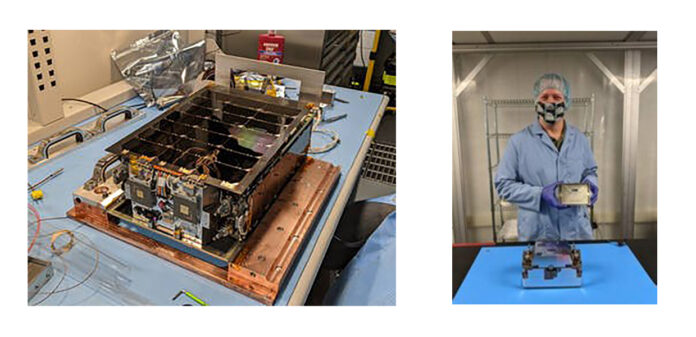HUNTSVILLE — In the beginning, engineers at NASA’s Marshall Space Flight Center built enormous rockets that have powered us deep into space, but now, they have packed their power into a packet the size of a briefcase.
Working with its commercial partners, Marshall has delivered one of the smallest propulsion systems in history, designed to help propel an upcoming NASA mission to the moon’s south pole in search of a more useful type of ice.
Marshall’s Lunar Flashlight is no larger than a briefcase, but is an innovative, low-cost CubeSat developed and managed by NASA’s Jet Propulsion Laboratory in California. The CubeSat will be carried on a SpaceX Falcon 9 rocket this year.
“We had to scale the propulsion technology down to something that could fit into a backpack, yet with all the same challenges of larger propulsion systems,” said Daniel Cavender, manager of the project at Marshall. “This was made easier by our strategic investments in small-satellite propulsion technologies over the past few years.”
As the spacecraft orbits the moon, its near-infrared lasers will shine light onto the permanently shadowed surface of the lunar pole. During this time, it will measure surface reflection and composition to identify large ice deposits.
This ice could be collected and purified for drinking water or converted into breathable oxygen or even into rocket fuel.
Designed in 2019, the system was delivered to the Jet Propulsion Laboratory in May 2021 for spacecraft integration. Lunar Flashlight will return to Marshall for fueling before being transported to NASA’s Kennedy Space Center in Florida for launch as a secondary payload on the same rocket as Intuitive Machines’ first mission under NASA’s Commercial Lunar Payload Services initiative.
Lunar Flashlight will take roughly six months to reach the moon, where it will achieve a polar orbit and begin its two-month primary mission.
Selected by NASA’s Artemis campaign development division in 2014, the Lunar Flashlight CubeSat mission is funded by NASA’s Small Spacecraft Technology program, part of the agency’s Space Technology Mission Directorate, via a NASA Small Business Innovation Research grant.
Work also benefited from partnerships with industry and academia. Marshall led the design of the compact propulsion system and oversaw hardware development in its in-house facilities and at Plasma Processes LLC of Huntsville and Flight Works of Irvine, Calif.
Researchers at the Georgia Institute of Technology’s Space Systems Design Lab in Atlanta built the fuel tank and electrical controller and led system integration and testing.
The tiny craft is fueled with a chemical monopropellant – a fuel capable of burning by itself without a separate oxidizer. Known as Advanced Spacecraft Energetic Non-Toxic, ASCENT was developed by the Air Force Research Laboratory and first tested on NASA’s Green Propellant Infusion Mission, which concluded in 2020, ASCENT is a “green,” low-toxic alternative to the conventional monopropellant hydrazine.
“CubeSats like this one are an ideal tool to demonstrate new technology while enabling compelling science and exploration,” Cavender said. “They have a relatively short design lifecycle and modest cost, yet the science return can be huge.”
NASA is seeking lunar ice deposits to answer longtime questions about the composition, quantity, and distribution of frozen water on the moon. The mission will help determine where it exists on the surface – and whether there is enough to sustain lunar colonies and to power lunar habitats and laboratories.
Beyond the obvious value of finding potable water for astronauts to drink, the ability to convert lunar water ice into hydrogen and oxygen – the basic requirements to make rocket fuel – could help establish a permanent fuel depot on the moon. This would help enable lunar launches of missions to Mars and other destinations.
“The mission will demonstrate our ability to use powerful, compact propulsive CubeSats for a variety of science missions at the moon and across the solar system,” Cavender said. “That’s a game-changing capability for exploration and planetary science.”
Don’t miss out! Subscribe to our email newsletter to have all our smart stories delivered to your inbox.



